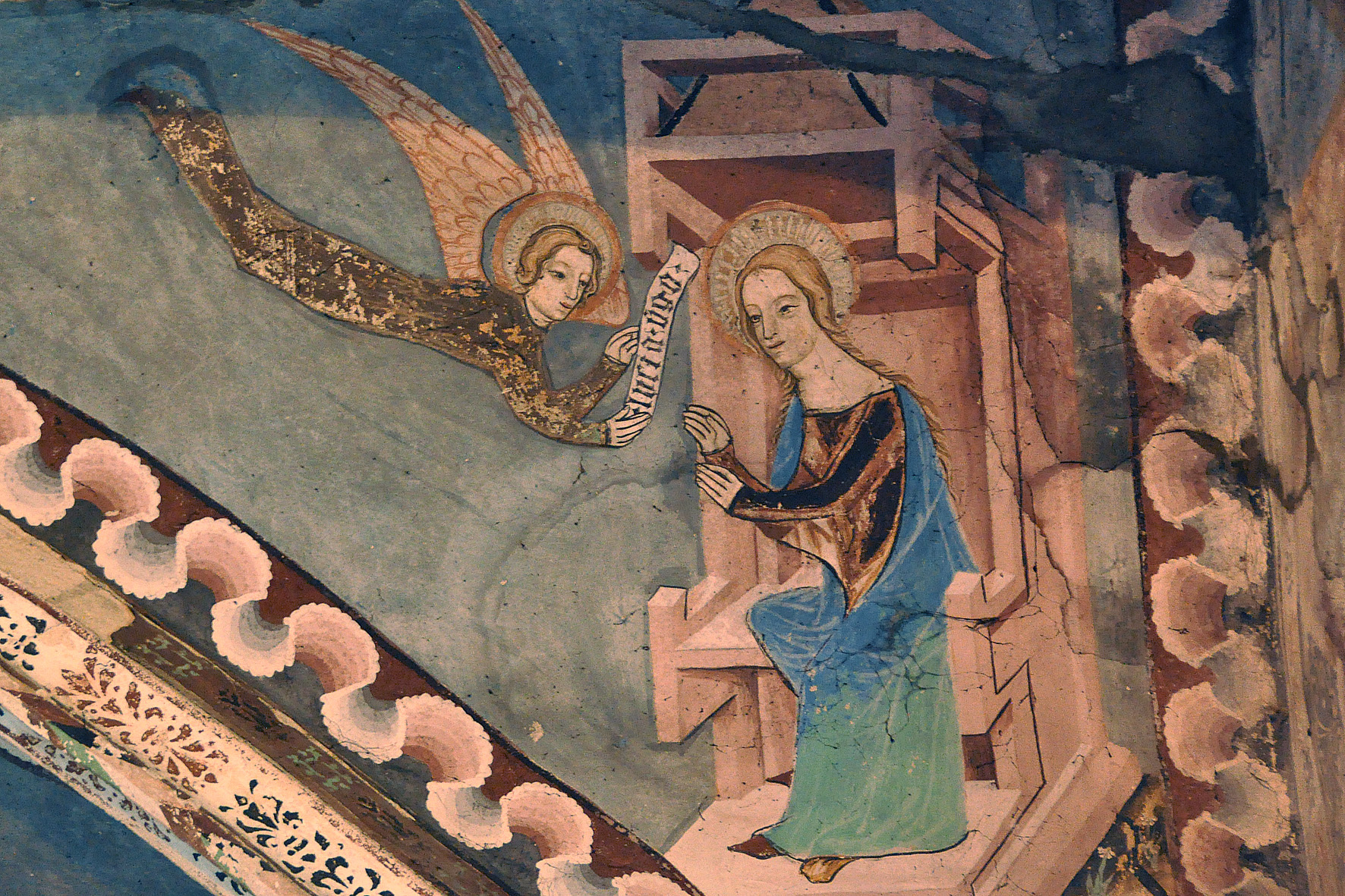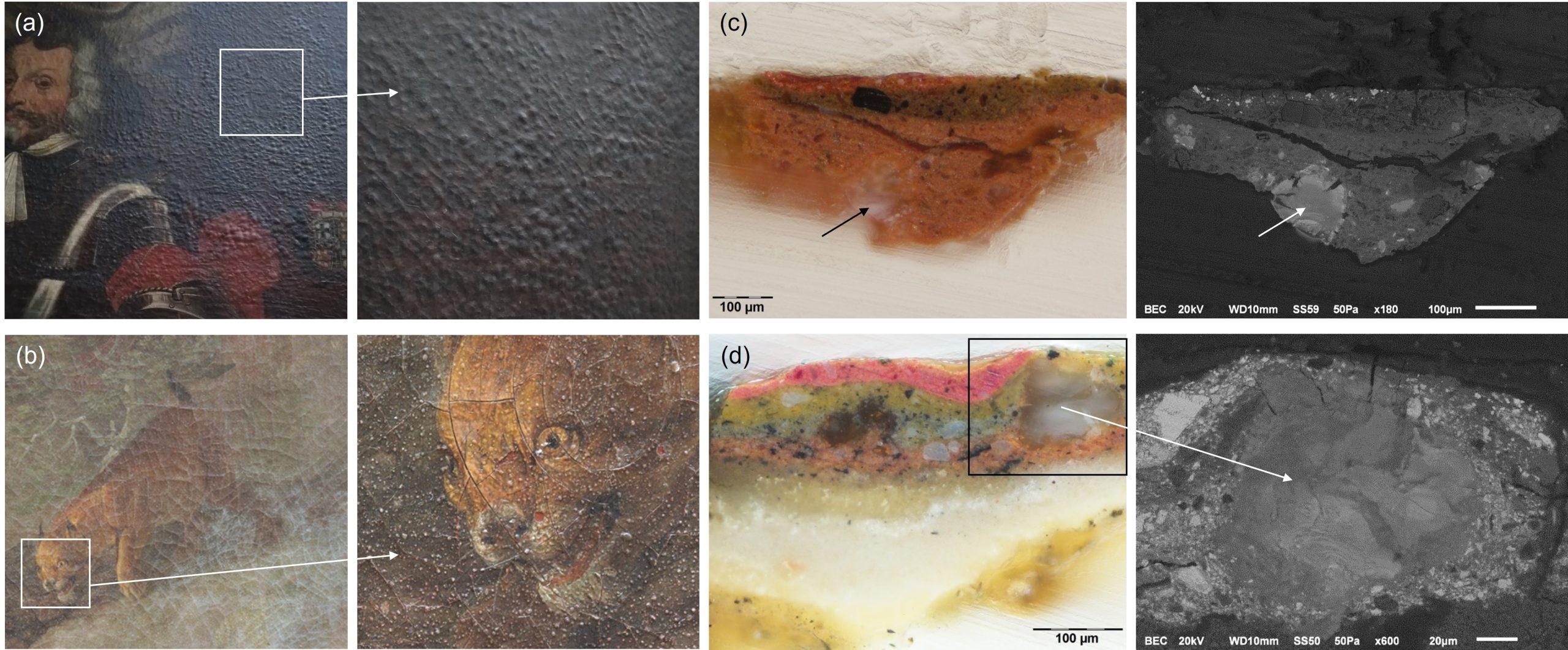Contact person: Silvie Švarcová
A systematic study of secondary changes that cause serious and undesirable changes of original appearance of artworks (such as colour changes or loss of coherence of paint layers) represents an important aspect of investigation of materials in paintings. Within these studies, we combine detailed examination of micro-samples of works of art with model experiments simulating reactions of individual components of paintings under various conditions. These reflect the diverse factors that may affect the paintings (temperature, humidity, light, UV radiation, salt solutions, metabolites of microorganisms, conservation treatment agents, etc.).
Besides the stability of painting materials in wall paintings (Fig. 1), which tend to be the most affected artworks as they are exposed to unsuitable climate conditions and aggressive substances from the surroundings, we also study interactions between pigments and binders.

Figure 1: Photograph illustrating blue to green colour change of Virgin Mary’s drapery caused by chloride attack. Wall painting in the Virgin Mary Church in Mӑlâcrav, Transylvania, Romania. © J. Hradilová, ALMA Laboratory
An undesirable type of pigment-binder interaction is represented, e.g., by saponification of fatty binders (that contain triglycerides of fatty acids, such as oils, egg yolk and/or their emulsions) leading to the formation of secondary metal carboxylates. The saponification may cause transparency of colour layers or their mechanical damage due to the expansion and growth of soap aggregates through the paint layers (Fig. 2).

Figure 2: Examples of saponification of oil paintings manifested both in macro- and microscale: (a) blisters on the painting “Portrait of Grand Master” (unknown artist, end of the 17th century?, National Heritage Institute, Bruntál Castle); (b) protrusions and flaking of paint layers on the painting “Leopards Attacking Deer in the Rocky Landscape” (C. A. Ruthard *1630-†1703; National Heritage Institute, Náměšť nad Oslavou Castle); (c) microphotograph of soap inclusion in earthy ground layer (on the left in visible light, on the right in back-scattered electrons); (d) aggregate of soaps growing through a sequence of paint layers, causing their deformation (on the left in visible light, on the right in back-scattered electrons) © B. Valchářová, M. Král © ALMA Laboratory
Our research in this field has deepened the knowledge about saponification in egg yolk-based binders, about influence of humidity as well as of different reactivity of various lead-based pigments on the saponification process. Furthermore, we have discovered and explained the formation of lead formate, an unexpected product of autooxidation of drying oils. In cooperation with colleagues specializing in synthesis and crystal structure determination, we have prepared simple as well as mixed lead and mercury carboxylates with long chain (palmitate-stearate series) and we have described their crystal structures (Fig. 3). Therefore, a long-lasting lack of crystal structure data of these compounds has been overcome, which leads to the possibility of unambiguous identification of crystalline metal carboxylates in paintings, as we have successfully shown on mercury and lead carboxylates in degraded miniature portraits.

Figure 3: Crystal structure of lead palmitate-stearate.
Currently, we focus on deepening the understanding of formation mechanisms of crystalline metal carboxylates in various systems. Our goal is to understand the influence of individual factors, and in consequence, to identify effective preventive measures that would forestall or considerably decelerate the saponification processes.
References:
- Barannikov R., Vykydalová A., Bezdička P., Hermans J., Plocek J., Švarcová S.: Thermal behavior of mercury carboxylates as paintings’ degradation products. Journal of Thermal Analysis and Calorimetry (2024); https://doi.org/10.1007/s10973-024-13463-3
- Garrappa S., Bezdička P., Švarcová S., Hradilová J., Pech M.; Hradil D.: Non-invasive evidence of mercury soaps in painted miniatures on ivory, European Physical Journal Plus 138 (2023) 219; https://link.springer.com/article/10.1140/epjp/s13360-023-03847-z
- Horká H., Šťastný M., Bezdička P., Švarcová S.: Determination of methanol-derivatives in drying oils after metal oxide-based dispersive solid phase extraction/QuEChERS clean-up, Journal of Chromatography A 1681 (2022) 463490; https://www.sciencedirect.com/science/article/pii/S0021967322006823?via%3Dihub
- Barannikov R., Kočí E., Bezdička P., Kobera L., Mahun A., Rohlíček J., Plocek J., Švarcová S.: Long-chain mercury carboxylates relevant to saponification in oil and tempera paintings: XRPD and ssNMR complementary study of their crystal structures, Dalton Transactions 51 (2022) 4019-4032; https://pubs.rsc.org/en/content/articlelanding/2022/dt/d1dt04160f
- Garrappa S., Hradil D., Hradilová J., Kočí E., Pech M., Bezdička P., Švarcová S.: Non-invasive identification of lead soaps in painted miniatures, Analytical and Bioanalytical Chemistry 413 (2021) 263-278; https://link.springer.com/article/10.1007/s00216-020-02998-7
- Švarcová S., Kočí E., Bezdička P., Garrappa S., Kobera L., Plocek J., Brus J., Šťastný M., Hradil D.: Uncovering lead formate crystallization in oil-based paintings, Dalton Transactions 49 (2020), 5044-5054, https://doi.org/10.1039/D0DT00327A
- Garrappa S., Kočí E., Švarcová S., Bezdička P., Hradil D.: Initial stages of metal soaps` formation in model paints: the role of humidity. Microhemical Journal 156 (2020), 104842; https://www.sciencedirect.com/science/article/pii/S0026265X19321848?via%3Dihub
- Kočí E., Rohlíček J., Kobera L., Plocek J., Švarcová S., Bezdička P.: Mixed lead carboxylates relevant to soap formation in oil and tempera paintings: the study of the crystal structure by complementary XRPD and ssNMR, Dalton Transactions 48 (2019), 12531-12540.5044-5054, https://doi.org/10.1039/C9DT02040C
- Švarcová S., Kočí E., Plocek J., Zhankina A., Hradilová J., Bezdička P.: Saponification in egg yolk-based tempera paintings with lead-tin yellow type I, Journal of Cultural Heritage 38 (2019) 8-19; https://www.sciencedirect.com/science/article/pii/S1296207418306940?via%3Dihub
- Čermáková Z., Švarcová S., Hradilová J., Bezdička P., Lančok A., Vašutová V., Blažek J., Hradil D.: Temperature-related degradation and colour changes of historic paintings containing vivianite, Spectrochimica Acta Part A-Molecular and Biomolecular Spectroscopy 140 (2015) 101; https://www.sciencedirect.com/science/article/pii/S1386142514018629?via%3Dihub
- Hradil D., Hradilová J., Bezdička P., Švarcová S., Čermáková Z., Košařová V., Němec I.: Crocoite PbCrO4 and mimetite Pb5(AsO4)3Cl: rare minerals in highly degraded mediaeval murals in Northern Bohemia, Journal of Raman Spectroscopy 45 (2014) 848-858; https://analyticalsciencejournals.onlinelibrary.wiley.com/doi/10.1002/jrs.4556
- Hradil, D; Hradilová, J; Kocí, E; Svarcová, S; Bezdicka, P; Maríková-Kubková, J: Unique Pre-Romanesque Murals in Kostolany Pod Tribecom, Slovakia: The Painting Technique and Causes of Damage, Archaeometry 55 (2013) 691-706; https://onlinelibrary.wiley.com/doi/10.1111/j.1475-4754.2012.00704.x
- Švarcová S., Hradil D., Hradilová J., Kočí E., Bezdička P.: Micro-analytical evidence of origin and degradation of copper pigments found in Bohemian Gothic murals, Analytical and Bioanalytical Chemistry 395 (2009) 2037-2050; https://link.springer.com/article/10.1007/s00216-009-3144-7
- Kotulanová, E; Bezdicka, P; Hradil, D; Hradilová, J; Svarcová, S; Grygar, T: Degradation of lead-based pigments by salt solutions, Journal of Cultural Heritage 10 (2009) 367-378; https://www.sciencedirect.com/science/article/pii/S1296207409000533?via%3Dihub